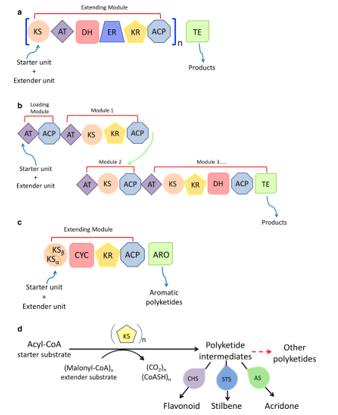v-innovate Technologies can provide a high-throughput substance detection and analysis technology based on liquid chromatography-tandem mass spectrometry (LC-MS/MS), which can be used to identify, quantify, and analyze the mechanism of metabolism of polyketides. This method has simple operation steps and can obtain high-sensitivity and reproducible analysis reports, which can help researchers to obtain rapid application of polyketides in the medical and health industry, the development, and research of metabolic drugs.
Polyketide is a general term for compounds synthesized by polyketide biosynthetic pathway. Polyketides have great application value in anti-infection, anti-fungal, anti-tumor and immunosuppressive aspects. Polyketides are mainly synthesized by polyketide synthase(PKS), which can be divided into PKS I, PKS II, and PKS III. Polyketides are divided into two types: aromatic cyclic polyketides and non-aromatic cyclic polyketides, that is, macrocyclic polyketides. These two types of compounds are synthesized by type II polyketide synthase synthesis pathway(PKS II) and type I polyketide synthase synthesis pathway(PKS I) respectively. N-methylation plays an important role in the biosynthesis of aromatic polyketides, when 4-amino anhydrotetracycline(ATC) is used as a substrate and incubated with purified oxo thiamine (OxyT) in the reaction system. HPLC/MS results show that ATC is only produced in the presence of OxyT(Figure 1). Experiments show that OxyT is a catalytically active substance with N-methylation, which can catalyze monomethylation and demethylation reactions, which proves the potential of OxyT in the biosynthesis of innovative aromatic polyketides. Among them, PKS I is mainly composed of functional domains such as keto synthase(KS), enol reductase(ER), acyltransferase(AT), dehydrogenase (DH), and ketoreductase(KR); PKS II mainly catalyzes Synthesis of tetracyclic and anthracycline compounds; PKS III is mainly chalcone synthase, mainly exists in the plant kingdom, and is responsible for the synthesis of flavolin and other components(Figure 2). With the LC-MS/MS method, neutral loss(NL) detects polyketides which is characterized via their fragmentation patterns, and then selection reaction monitoring(SRM) quantify its contents.
 Figure 1. N-methyltransferase OxyT involved in biosynthesis of ATC. (Wang 2020).
Figure 1. N-methyltransferase OxyT involved in biosynthesis of ATC. (Wang 2020).
 Figure 2. Catalytic reaction of PKSs. (Wang 2020).
Figure 2. Catalytic reaction of PKSs. (Wang 2020).
Our operation technology process meets the requirement of lower detection limit (minimum limit of quantification is 0.0002-0.01μg/kg), and calmly copes with the detection and analysis of polyketides in complex matrix. The sample does not need to be derivatized and the automatic mode is used for detection and analysis, which can ensure the integrity of the sample and reduce human error, so it can achieve high-throughput detection and obtain more accurate analysis reports.
 Figure 3. Polyketides analysis service workflow.
Figure 3. Polyketides analysis service workflow.
Detection method: LC-MS/MS
Monitoring phase: A: acetonitrile, B: water (containing 0.1% formic acid, 2.0 mM ammonium acetate)
Flow rate: 0.4 ml/min
Running time: 10 min
Elution mode: gradient elution
Ion source mode: electrospray ion source, positive ion mode (ESI+)
Back blow: 75
Atomization gas: 220
Ion source spray voltage: 5000 V
Recovery rate: 92.25-105.87%
Method reproducibility: 1.53-4.78%
Lowest limit of quantification: 0.0002-0.01μg/kg
Analysis content:
1. Tissues such as leaves, roots, stems, flowers, fruit pulp, peel tissue, etc., larger leaves need to be quickly cut into pieces with scissors, and the separated samples are quickly washed with sterilized water, and the absorbent paper is immediately put into the liquid after absorbing the excess water. Quickly freeze in nitrogen for more than 2 minutes, and then transfer to -80°C for storage to avoid repeated freezing and thawing.
2. Cell samples, centrifuge after sampling, remove the culture medium, immediately put them in liquid nitrogen for quick freezing for more than 2 minutes, and then transfer to -80°C for storage.
3. For each sample, take no less than 3 g for fresh samples, no less than 1 g for dry samples. At least three biological replicates in each group, prepare a backup. The measured sample will not be returned, please keep a backup.
Using the combined method of LC and MS can obtain high-quality identification and quantitative analysis reports of polyketides and their metabolites, which can help researchers to increase their understanding of the types of active molecules and molecular mechanisms of polyketides. v-innovate Technologies strives to provide you with more valuable and innovative research tools and solutions in the analysis and application of polyketide related fields.
References
